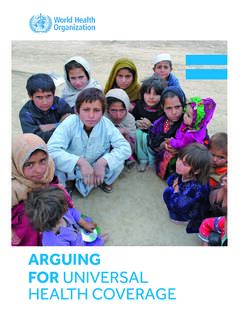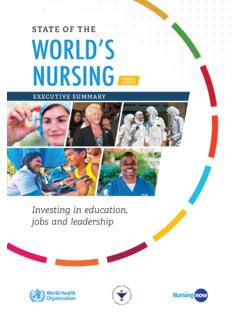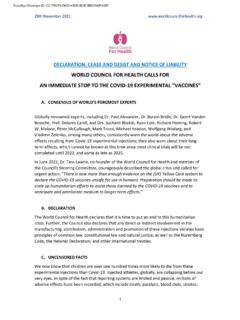Transcription of 2020 - World Health Organization
1 202020202020 World Health statistics 2020: monitoring Health for the SDGs, sustainable development goalsISBN 978-92-4-000510-5 (electronic version)ISBN 978-92-4-000511-2 (print version) World Health Organization 2020 Some rights reserved. This work is available under the Creative Commons Attribution-NonCommercial-ShareAlike IGO licence (CC BY-NC-SA IGO; ). Under the terms of this licence, you may copy, redistribute and adapt the work for non-commercial purposes, provided the work is appropriately cited, as indicated below. In any use of this work, there should be no suggestion that WHO endorses any specific Organization , products or services. The use of the WHO logo is not permitted. If you adapt the work, then you must license your work under the same or equivalent Creative Commons licence.
2 If you create a translation of this work, you should add the following disclaimer along with the suggested citation: This translation was not created by the World Health Organization (WHO). WHO is not responsible for the content or accuracy of this translation. The original English edition shall be the binding and authentic edition . Any mediation relating to disputes arising under the licence shall be conducted in accordance with the mediation rules of the World Intellectual Property citation. World Health statistics 2020: monitoring Health for the SDGs, sustainable development goals. Geneva: World Health Organization ; 2020. Licence: CC BY-NC-SA (CIP) data. CIP data are available at , rights and licensing. To purchase WHO publications, see To submit requests for commercial use and queries on rights and licensing, see materials.
3 If you wish to reuse material from this work that is attributed to a third party, such as tables, figures or images, it is your responsibility to determine whether permission is needed for that reuse and to obtain permission from the copyright holder. The risk of claims resulting from infringement of any third-party-owned component in the work rests solely with the disclaimers. The designations employed and the presentation of the material in this publication do not imply the expression of any opinion whatsoever on the part of WHO concerning the legal status of any country, territory, city or area or of its authorities, or concerning the delimitation of its frontiers or boundaries. Dotted and dashed lines on maps represent approximate border lines for which there may not yet be full agreement.
4 The mention of specific companies or of certain manufacturers products does not imply that they are endorsed or recommended by WHO in preference to others of a similar nature that are not mentioned. Errors and omissions excepted, the names of proprietary products are distinguished by initial capital reasonable precautions have been taken by WHO to verify the information contained in this publication. However, the published material is being distributed without warranty of any kind, either expressed or implied. The responsibility for the interpretation and use of the material lies with the reader. In no event shall WHO be liable for damages arising from its use. Photo credits: page 1 WHO / Karen Reidy; page 6 WHO / Lindsay Mackenzie; pages 12, 19 WHO / NOOR / Sebastian Liste; page 23 WHO / Simon LimDesign and layout by L IV Com S rliiiMONITORING Health FOR THE SDGsCONTENTSF oreword.
5 IvAbbreviations and acronyms ..vIntroduction ..viKey messages ..vii1. Major gains in life expectancy in low-income countries ..12. Fewer maternal and child deaths, and gains against major epidemics ..63. Trends in noncommunicable disease mortality and risk factors, and deaths from injuries and violence ..124. Dealing with data challenges ..195. High-quality Health information and data ..23 Annex 1. Regional highlights of Health -related SDG indicators ..27 Annex 2. Tables of Health statistics by country, WHO region and globally ..41 Annex 3. WHO regional groupings ..77ivWORLD Health STATISTICS 2020 FOREWORDI have often said that to make progress, we must be able to measure Sustainable Development Goals offer a compelling vision of a healthier, safer, fairer World , with concrete targets to work towards across all of the most pressing Health challenges of our time.
6 Part of realizing that vision knowing where we are, so we can see what we need to do to reach our part of WHO s Transformation, we have worked to scale up to reporting country level data for 46 Health -related SDG indicators, which are presented in the World Health Statistics 2020. The 2020 edition finds steady improvements in many key Health indicators, while showing that we are still lagging in other areas. We have made remarkable progress in several important indicators, such as reductions in maternal, neonatal and child mortality since 2000, but there is still a long way to go to meet the SDG targets. There is mixed news about noncommunicable diseases, the World s leading causes of death. While the overall rate of premature deaths related to noncommunicable diseases has declined in the past two decades, progress has slowed since 2010 and key risk factors such as obesity are on the rise.
7 Monitoring progress depends on strong country data and Health information systems. There are large gaps in the availability of SDG data in many parts of the World . Strengthening country capacity for data and information requires collaboration across governmental and non-governmental institutions, including ministries of Health and finance, national statistics offices, offices of the registrar general, local and regional government, and think tanks and of the key lessons from the COVID-19 pandemic is that we must invest in data and Health information systems, as part of our overall public Health capacity, before a crisis strikes. To emerge from this crisis stronger, we must be able to monitor progress with real-time, reliable and actionable data.
8 Strong Health data systems are a core requirement for improving population Health outcomes and meeting the SDG Health targets. WHO is committed to working with the international community to provide support for these critical systems, so that every country can have reliable, timely, accessible data. Strong Health information systems are one of the cornerstones of our mission to promote Health , keep the World safe and serve the Tedros Adhanom Ghebreyesus Director-GeneralWorld Health OrganizationvMONITORING Health FOR THE SDGsAIDS acquired immunodeficiency syndromeARTantiretroviral therapyCRVS civil registration and vital statisticsDBPdiastolic blood pressureDOTS directly-observed treatment, short-courseDTP3diphteria, tetanus and pertussis vaccine (third dose)GHOG lobal Health ObservatoryGPW1313th Global Programme of WorkHALE healthy life expectancyHIVhuman immunodeficiency virusHPVhuman papillomavirusICD-10 International Statistical Classification of Diseases and Related Health Problems (10th revision)
9 IHRI nternational Health RegulationsIPVintimate partner violenceITNinsecticide-treated netMDGM illennium Development GoalMMRmaternal mortality ratioNCDnoncommunicable diseaseNSOnational statistics officeNTDneglected tropical diseaseRHIS routine Health information systemsSBPsystolic blood pressureSDGS ustainable Development GoalTBtuberculosisUHCuniversal Health coverageUNUnited NationsUNICEFU nited Nations Children s FundVAWviolence against womenWHOW orld Health OrganizationWHS+ World Health Survey PlusABBREVIATIONS AND ACRONYMSviWORLD Health STATISTICS 2020 INTRODUCTIONThe World Health statistics 2020 report is the latest annual compilation of Health statistics for 194 Member It summarizes trends in life expectancy and causes of death and reports on progress towards the Health and Health -related Sustainable Development Goals (SDGs) and associated targets.
10 Four indicators of emerging public Health importance relating to poliomyelitis, hypertension and obesity in adults and school age children have been included. These are part of the WHO s Thirteenth General Programme of Work 2019 2023 (GPW13), which the 71st World Health Assembly approved in May The GPW13 is largely based on the SDGs and sets out WHO s strategic direction until also assesses the current availability of data for the indicators, and describes the data gaps and WHO s efforts to support countries to improve Health information systems. Regional statistics and highlights are provided in Annex 1, while country-level statistics for selected Health -related SDG indicators are presented in Annex 2, along with the lists of countries in the WHO Regions (Annex 3).













